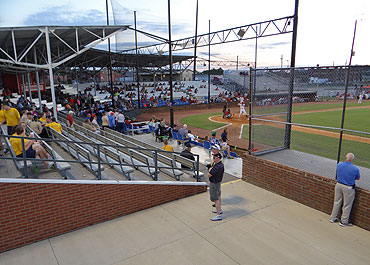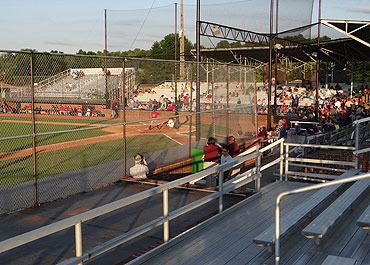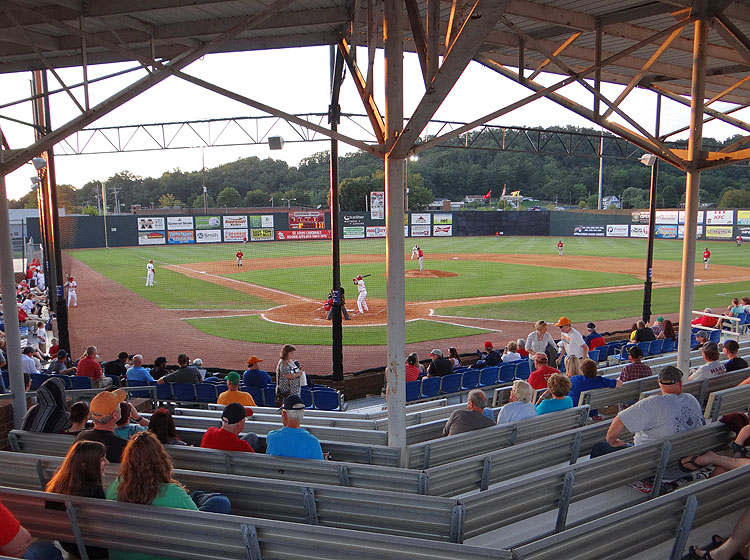
 Baseball Pilgrimages Baseball Pilgrimages
| Ballpark Info |
Directions
Seating Diagram
Tickets
Phone: 423-461-4866
|
| Field Facts |
Outfield Dimensions
LF: 330' CF: 400' RF: 315'
Playing Surface
Combination of Kentucky bluegrass and rye grass
Home Dugout
3rd Base
|
| Team Info |
Level: Rookie
League: Appalachian
Affiliate: St. Louis Cardinals
2017 Schedule
|
| Ballpark Attendance |
| Year | Total | Average |
2016
2015
2014
2013
2012
2011
2010
2009
2008
2007
2006
2005
2004
2003
2002
2001 |
51,855
39,118
40,351
25,612
24,827
25,961
24,049
23,639
21,327
21,101
23,009
24,338
19,940
31,261
37,786
42,816 |
1,673
1,304
1,261
826
801
764
752
739
688
703
719
761
623
1,158
1,181
1,381 |
| * Attendance figures listed are the regular season totals drawn by the Johnson City Cardinals at Cardinal Park |
Baseball Pilgrimages
Where the pursuit of baseball never ends.
[Site Map]
|
|
 |
A bastion of basicness, Johnson City's ballpark dates to a much simpler era and it shows as the longtime home of low-level Cardinals baseball is a prime example of old-school stadium construction and style.
Officially known as Howard Johnson Field at Cardinal Park, but generally just called one or the other part of that name, the ballpark has a lot of aluminum, plenty of netting and fencing to mostly prevent balls from clanging on it, and just enough brick to give the place some class.
While all of the small park's stands are situated within the infield, most of the seats are bleachers and every one is behind tall netting or chain link fencing. Combined with the numerous poles in the place, either to support the backstop netting or the tin roof that covers the main grandstand, there are plenty of obstructed views within the collective confines of Cardinal Park, which has a very tall wooden outfield wall that frames the playing field.
Those sitting in the roof-covered grandstand do so on an aluminum base, upon which backed bleachers or simple plastic seats are separated by a concrete aisle. The wall in front of the grandstand, and the dugouts themselves, are built of brick, allowing for some throwback appeal attractiveness, although the grandstand itself suffers from a caged in ambiance caused by the netting attached to its roof. To be out in the open air means sitting in freestanding bleachers behind each dugout, but fencing of the chain-link variety is stacked upon each and creates an unpleasant barrier there.
The overabundance of protection detracts from the ballpark's intimacy, although its quaintness is unabated on the concourse behind the grandstand, where the team store is in a shed and concessions are limited to one stand.
Essentially, this is a simple place and that's underscored by the fact no modern style of seats or suites are found here. But Howard Johnson Field also doesn't have the charm you'd hope for from a ballpark of its vintage: a stadium first sprung up on the site where a field had long been in the 1950s. It also doesn't help that the sun can be blinding for those sitting on the first base side during the early innings of evening games.
But if you want to see a game in a stadium that is laid out like they used to be, on grounds where baseball has long been played, and don't mind doing so in a venue with sightline struggles, then you can't get much more authentic than this classic.
Garden-variety once upon a time this kind of shrine is commonplace no more, and that makes Cardinal Park either a treasure or a testament as to why modern ballparks are so much better than their predecessors.

Location
Cardinal Park is found within Memorial Park, which is very close to Interstate 26. The ballpark is just a half-mile from I-26 and to get there you take exit 23 and then go east on Main Street (signs will point the way).
The ballpark is on Legion Street across from a railroad track and just past a big building that says "parks & recreation" on its facade. The number (111) used for the ballpark's Legion Street address is actually associated with the parks and rec center, which is where the team's offices are located.
As for Memorial Park, it's home to plenty of things besides a baseball stadium as it was designed to be a community gathering place for numerous activities. So within the park you'll find a swimming pool, tennis courts, an amphitheater, a very large community and senior center (67,000-square-foot large), and, as its name suggests, memorials dedicated to local soldiers who died in wars abroad.
Johnson City is the most populated place in which a team in the small city based Appalachian League plays and the downtown area for the circa 65,000 person city is on the other side of I-26. The city is also a college town, as it's home to East Tennessee State University. The school has about 15,000 students enrolled annually and its campus is less than two miles from where the Cardinals play.
Parking
A large paved parking lot extends from behind home plate to down the right field line and well beyond. The lot is always free to park in and is entered from Legion Street just past the white Memorial Park Community Center sign.
 |
 |
| Bleachers, netting and poles are a common sight, but so is a lot of brick, at Johnson City's Cardinal Park, so named for the team that has played there since 1975. |
Features & Layout
In lieu of a facade, the ballpark has a perimeter black wrought iron fence supported by brick columns. Its concourse is between the fence and stadium structure.
There's only one way in and out of the ballpark, and that's via a gate on the first base concourse that is adjacent to the two-window box office.
The concourse is narrow behind the third base stands and is plaza-like wide behind home plate and the first base stands. On the concourse behind home plate is the ballpark's single permanent concession stand (it's in a brick building) and small team store, which is a shed that cannot be entered (you browse and buy at its window). Bathrooms are in a lengthy brick-faced building at the back of the first base stands. At the end of the concourse on its first base side is a small kids' area, which mainly consists of an inflatable that's behind the bleachers.
Tall backstop netting fronts all grandstand sections, which span between the dugouts but not behind or beyond them. Seating within the grandstand is comprised of 11 rows of high-backed bleachers and three rows of individual seats. A concrete aisle is between the two types of seats and the individual seating that is in front of the aisle is simply blue plastic seats fastened onto bleachers, so the seat itself cannot be pushed up or down. All 14 rows of grandstand seating are set on an aluminum base. Except for the end section on each side, the grandstand is covered by a roof. The roof is made of tin and it's supported by 10 rusting poles that, along with the backstop's netting supports, obstruct views.
Freestanding sections of bleachers are behind the dugouts and extend just a little past each. The bleacher sets on both sides are identical. Each has 15 rows of backless benches. Coincidentally, the company that made these bleachers is the same one that supplied the outfield bleachers used at Busch Stadium in St. Louis. That's Dant Clayton and their branding imprint listing the product type (Alum-A-Stands) and manufacturer's location (Louisville, KY) can easily be seen on the end of each bleacher row.
All ticketed seating is within the infield, as even the bleacher seats that are the furthest distance from home plate donít quite make it to the edge of the infield diamond dirt.
The only group area is well down the left field line, where a covered picnic pavilion has numerous plastic tables in it. Since the group pavilion area is pretty far from the field it's generally only useful for pre-game picnics.
The press box is just that -- a box, and one that has a mere 90 square feet of space for its 4-person capacity. The small press box is above the sole entry portal within the grandstand, which is directly behind home plate, and on its backside is the ballpark's name. That's the only place you'll see it mentioned upon approach, as there is no exterior signage on or near Cardinal Park grounds.
On the brick walls within the grandstand's portal are plaques dedicated to two longtime Johnson City parks and recreation directors, Howard Johnson (1944-1977) and Lonnie E. Lowe (1977-1998). The field is named for Johnson. A street named for Lowe used to run alongside the first base side of the stadium but was removed.
Both dugouts are built of brick and the backstop walling between them is also made of brick. Two stories of chain-link fencing are on the roof of each dugout, which is a stark contrast to the protective netting that is used everywhere else.
Bullpens are adjacent to the dugouts. The Johnson City bullpen is in a fan accessible area, the visitorsí is not. At each location the home plate area is up against the far brick end of the dugout.
A very tall wooden wall completely encircles the outfield. It's a uniformly tall five plywood boards high, which equates to 20 feet.
A scoreboard is flush with the upper portion of the fence in left-center field. Electronically operated, it's the sole scoreboard in Cardinal Park and is a simple line score-style board that was manufactured by Electro-Mech in Wrightsville, GA.
Clubhouses for both teams are down the right field line.
The ballpark's beyond the outfield fence backdrop is a sizable tree-covered hill, and small homes at its base can be seen throughout the stands when looking past the center field wall. Those sitting in the ballpark are also afforded a view of a smaller hill that's sans any trees on the right field horizon, but that treeless and mostly green mound is manmade as it's actually a part of the regional landfill known as the Iris Glen Environmental Center, which opened in 1994 on the site of an abandoned shale mine.

|
Cardinal Park Facts, Figures & Footnotes
Howard Johnson Field at Cardinal Park is the ballpark's full and official name.
The first time Howard Johnson's name was attached to the park was in 1977, following his retirement from Johnson City's parks and recreation department, for which he was the original director and served 33 years in that role. A plaque presented to Johnson in a ceremony on June 15, 1977 is affixed to the wall in the entryway beneath the press box. The Cardinals' 1977 season home opener on June 24 was to be the first time a game was played at "Howard Johnson Field," but rainouts pushed that back to July 2, 1977, when Johnson City swept a doubleheader from the Bluefield Orioles to officially begin the Howard Johnson Field era.
A major renovation finished in time for the 1994 season gave the grandstand and dugouts their present look. So the grandstand's current seating and the brick dugouts and backstop all debuted in 1994.
Owned by the City of Johnson City. Maintained by the Johnson City Parks and Recreation Department.
Leased to the Johnson City Sports Foundation, which pays a facility user fee for each home game played by the Johnson City Cardinals. The team is owned by the St. Louis Cardinals but is operated on a non-profit basis by the Foundation.
The ballpark occupies 5 acres within the southeast portion of Memorial Park.
Long famous for its in-play hill in right field, the approximately 45-degree sloped grassy incline that led up to the outfield fence was removed following the 2010 season. The unique berm reached a height of 15 feet and was a necessary quirk, as its backside helped to form the seating bowl at Memorial Stadium, which surrounded Steve Spurrier Field for as long as football was played next door to Cardinal Park in the hometown of the "Head Ball Coach." The football stadium, which actually predated the ballpark, was torn down in 2010, which directly led to the demise of one of the most notable features at a minor league ballpark in the modern era.
A streetscape project completed in 2014 removed the road, Lonnie Lowe Lane, that used to run parallel to the ballpark's first base side. A wide sidewalk-style walkway now traces that side of the ballpark's perimeter and its construction was part of the $225,000 spent then on upgrades to the entrance area at Cardinal Park, which included the addition of the present ticket office plus the wrought iron fencing and brick columns that form the park's front perimeter.
Three flag poles are behind the wall in straightaway center field. The middle pole is the tallest and on it flies the American flag. It's flanked on one side by the Tennessee state flag, which was adopted in 1905 after being designed by a Johnson City native and attorney by the name of LeRoy Reeves.
Is also the home field for the Science Hill High School Hilltoppers baseball team. In 2014, pitcher Daniel Norris became the first player drafted from the school to make it to the majors.
Was home to the East Tennessee State University baseball team for many years. That changed in 2012 when the NCAA Division I program opened Thomas Stadium, a 1,200-seat venue near the school's campus. The final game played by the ETSU Buccaneers at Cardinal Park was on May 14, 2011 when they defeated the Campbell Camels by a 13-9 score. In a role reversal, since 2013 the Johnson City Cardinals have played a small number of games at Thomas Stadium, which is 1½ miles from their minor league ballpark. The team's first game at the college stadium was on June 28, 2013, when an announced crowd of 825 saw the Cardinals lose 8-0 to the Bristol White Sox.
Ballpark Firsts
First game: June 26, 1957; the Johnson City Phillies beat the Kingsport Orioles, 12-8, at what was then referred to as Phillies' Field. The paid attendance was 1,311 and the game was played in 3 hours and 12 minutes. While no future future major leaguers took the field in the game, a minor league legend did as Steve Dalkowski, assumed to be the faster pitcher in baseball history, pitched one-third of an inning for Kingsport, for whom he made his professional debut in 1957.
The Appalachian League was on a one year hiatus in 1956, when the ballpark opened, so professional baseball was not played at the field in its first year. When the Johnson City Phillies debuted at the ballpark in the revived all-rookie league in 1957 the price for a ticket to each of the team's games was 50 cents.
Official ballpark firsts (all of which occurred on 6/26/57):
| Pitch | Batter | RBI | Home Run | Winning Pitcher | Losing Pitcher |
| Ed Lockhart | Curtis Priest | Freddie Hernandez | Freddie Hernandez | Ed Lockhart | Claude Hall |

|
|
